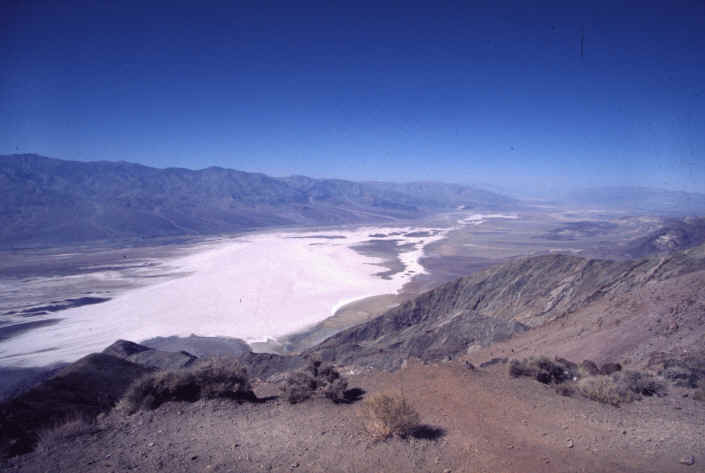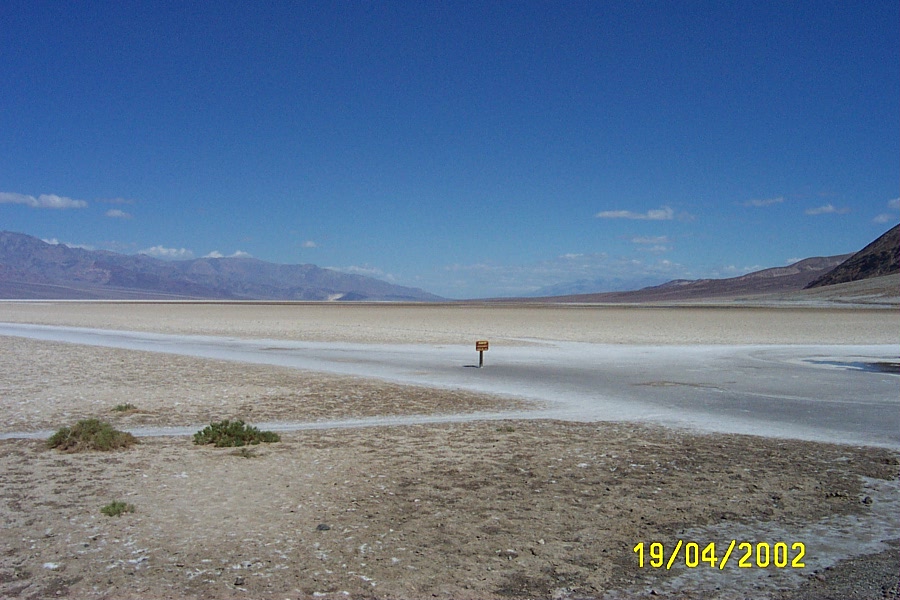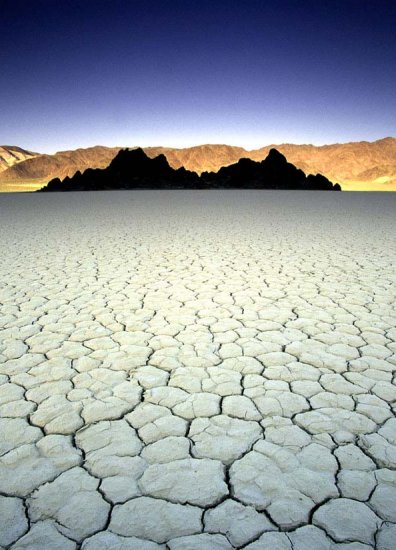Death Valley National Park, established on February 11, 1933, covers almost 3,000 square miles and is a vast natural museum, larger than the Yellowstone National Park. The floor of the Valley is almost 300 feet below sea level (at Badwater basin) and it is recognized as the lowest point in the Western Hemisphere and one of the hottest places on earth. 134 degrees F was recorded in 1913, second only to the 136 degrees registered in Libya in 1936. From the top of the 11,049 foot Telescope Peak in the Panamint Range Mountains, the floor of the Valley spreads out almost 2 miles below. It bears the grim name Death Valley.
All the great divisions of geological time. the eras and most of their subdivisions, are represented in the rocks of the mountains bordering the great valley. These rocks and the land forms tell a story of endless changes in the earth's crust - vast depositions, contortions, tiltings, alternate risings and lowerings, faultings and intense heats and pressures that changed the very nature of some rocks.

Climate too, has played its part. In recent geological time, powerful forces of water, wind, and gravity have sculptured much of the scenery that you see today. In the harsh environment of the floor of Death Valley, plants and animals must inexorably adapt and specialize - or perish. The average yearly rainfall here is less than 2 inches. Plants that do not grow near springs, pools, or other permanent water have developed specialized means to obtain and preserve water, or have adapted to quick growth and propagation through maximum use of the scant rains that fall upon them.
Between the valley floor and the mountain ridges, plant communities change in response to higher elevations that have lower temperatures, more rainfall and snow. Small animals in the dry valley, through largely dependent upon plants for survival, have made special adaptations that enable them to live on very little water. Larger animals are able to seek out water and predators obtain some water from the bodies of their victims.

This unique national park is open all year, but winter is the best time to visit the points of interest in the valley. The long, hot summer - from May through October - is only for the hardy and venturesome. Many of the side roads from the valley are closed during this season, but you will find the higher and cooler Panamint Mountains quite comfortable.
Evidence of the presence of man through hundred of years is found in almost every part of the valley. Rock drawings, campsites and foot trails remain as traces of the pre-historic hunters and gatherers.

When pioneer wagons with the first white men entered the valley on Christmas Day 1849 (the "Forty-Niners"), the area was inhabited by Panamint Indians. They were ill-adviced emigrants looking for a short cut to the gold fields of California. As hardships increased, the wagon train separated into smaller groups, such as the Jayhawkers and the Bennet-Arcane party, each with its own theory of escape. This date marked the beginning of the turbulent modern history of Death Valley and its mountains. The Forty-Niners were followed by successive invasions of prospectors and miners seeking to exploit deposits of silver and other precious metals. Each ore strike gave birth to a new short-lived settlement. Even the "white gold of the desert", borax, failed to support a permanent community. Thus the 1849 chapter of Death Valley history is filled with tales of hardship and, in some cases, heroism of these first white people in the area - the ones who in happily crying , "Good-bye, Death Valley" , gave the area its name. Evidence of silver was brought out of the valley by some of the 49-ers, setting off exploration for the Lost Gunsight Silver Lode and other riches. But there was only 18 survivors out of the original party of 30. Some of them, in order to survive, slaughtered their oxen for food. They then burned the wagons and proceeded on foot seeking a trail westward out of the Valley.

The long history started of prospecting and mining in the Valley. Few of the dreams of the prospectors came true, yet there was some spectacular exceptions, and in these lie many an interesting Death Valley story.
Best known of all the prospectors was Death Valley Scotty, a colorful personality whose tales and exploits helped to publicize the Valley. Another short side trip to today's Visitors Center takes you to the old Harmony Borax Works from which, in the 1880's, famous 20 mule team borax trains hauled their loads (up to 46,000 pounds at a time) grueling 165 miles to the railroad in Mojave. Still standing among the crumbling adobe walls is the old broiler and some of the vats. This was the first successful borax works in the history of borax mining in Death Valley. Despite the existence of more deposits in the area, Harmony Borax was closed in 1890 when the operation was transferred to Daggett in the Calico Mountains, which was closer to rail transportation. In 1933, a presidential proclamation set aside a reservation of 2,980 sq. miles of desert land as a National Monument, thereby assuring its continued use for public enjoyment,


Today human presence is represented mainly by the annual half-million visitors drawn by the vastness of mountain panoramas, the pleasure of the winter climate, and the lore of frontier life.
All the great divisions of geological time. the eras and most of their subdivisions, are represented in the rocks of the mountains bordering the great valley. These rocks and the land forms tell a story of endless changes in the earth's crust - vast depositions, contortions, tiltings, alternate risings and lowerings, faultings and intense heats and pressures that changed the very nature of some rocks.

Climate too, has played its part. In recent geological time, powerful forces of water, wind, and gravity have sculptured much of the scenery that you see today. In the harsh environment of the floor of Death Valley, plants and animals must inexorably adapt and specialize - or perish. The average yearly rainfall here is less than 2 inches. Plants that do not grow near springs, pools, or other permanent water have developed specialized means to obtain and preserve water, or have adapted to quick growth and propagation through maximum use of the scant rains that fall upon them.
Between the valley floor and the mountain ridges, plant communities change in response to higher elevations that have lower temperatures, more rainfall and snow. Small animals in the dry valley, through largely dependent upon plants for survival, have made special adaptations that enable them to live on very little water. Larger animals are able to seek out water and predators obtain some water from the bodies of their victims.

This unique national park is open all year, but winter is the best time to visit the points of interest in the valley. The long, hot summer - from May through October - is only for the hardy and venturesome. Many of the side roads from the valley are closed during this season, but you will find the higher and cooler Panamint Mountains quite comfortable.
Evidence of the presence of man through hundred of years is found in almost every part of the valley. Rock drawings, campsites and foot trails remain as traces of the pre-historic hunters and gatherers.

When pioneer wagons with the first white men entered the valley on Christmas Day 1849 (the "Forty-Niners"), the area was inhabited by Panamint Indians. They were ill-adviced emigrants looking for a short cut to the gold fields of California. As hardships increased, the wagon train separated into smaller groups, such as the Jayhawkers and the Bennet-Arcane party, each with its own theory of escape. This date marked the beginning of the turbulent modern history of Death Valley and its mountains. The Forty-Niners were followed by successive invasions of prospectors and miners seeking to exploit deposits of silver and other precious metals. Each ore strike gave birth to a new short-lived settlement. Even the "white gold of the desert", borax, failed to support a permanent community. Thus the 1849 chapter of Death Valley history is filled with tales of hardship and, in some cases, heroism of these first white people in the area - the ones who in happily crying , "Good-bye, Death Valley" , gave the area its name. Evidence of silver was brought out of the valley by some of the 49-ers, setting off exploration for the Lost Gunsight Silver Lode and other riches. But there was only 18 survivors out of the original party of 30. Some of them, in order to survive, slaughtered their oxen for food. They then burned the wagons and proceeded on foot seeking a trail westward out of the Valley.

The long history started of prospecting and mining in the Valley. Few of the dreams of the prospectors came true, yet there was some spectacular exceptions, and in these lie many an interesting Death Valley story.
Best known of all the prospectors was Death Valley Scotty, a colorful personality whose tales and exploits helped to publicize the Valley. Another short side trip to today's Visitors Center takes you to the old Harmony Borax Works from which, in the 1880's, famous 20 mule team borax trains hauled their loads (up to 46,000 pounds at a time) grueling 165 miles to the railroad in Mojave. Still standing among the crumbling adobe walls is the old broiler and some of the vats. This was the first successful borax works in the history of borax mining in Death Valley. Despite the existence of more deposits in the area, Harmony Borax was closed in 1890 when the operation was transferred to Daggett in the Calico Mountains, which was closer to rail transportation. In 1933, a presidential proclamation set aside a reservation of 2,980 sq. miles of desert land as a National Monument, thereby assuring its continued use for public enjoyment,


Today human presence is represented mainly by the annual half-million visitors drawn by the vastness of mountain panoramas, the pleasure of the winter climate, and the lore of frontier life.



 7:12 AM
7:12 AM
 crkota
crkota





 Posted in:
Posted in: 

0 comments:
Post a Comment